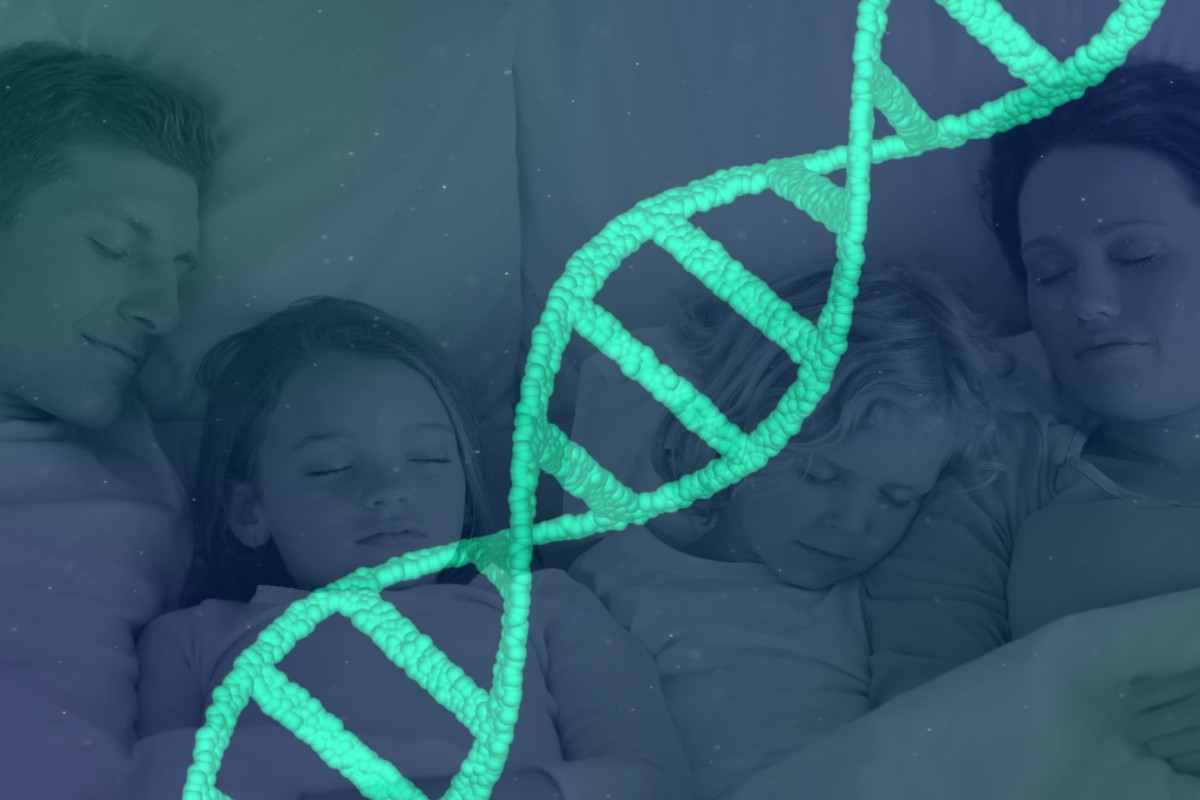
DNA Day: What has Sleep got to do with DNA & Vice Versa?
April 25th marks ‘DNA Day’ which commemorates the discovery of the structure of DNA in 1953, and of the sequencing of the human genome in 2003.
What is DNA?
DNA encodes the genetic information which is unique to each individual. It provides the blueprint for all the proteins that are the building blocks of our bodies and which enable us to grow, to function and reproduce. The information coded in DNA is hereditary; it passes from parent to child.
It probably seems obvious that our sleep patterns are influenced by our environment (such as how light it is) and our behaviours (such as setting an alarm clock), but recent research has shown that genetics also have a role to play. In fact, most sleep disorders have a genetic component, which influences our vulnerability to developing that condition. In this post we explore what is known about the extent to which our genes influence our sleep, but we begin with the critical importance of sleep for maintaining the health of our DNA.
Sleep enables DNA repair
During our waking hours, our DNA is exposed to various stressors which can cause damage. These include exposure to UV radiation, and exposure to metabolic byproducts called reactive oxygen species. While DNA repair is a continual process, it is more efficient during sleep. Studies in the neurons or nerve cells of zebrafish revealed that sleep deprivation can accelerate DNA damage (Zada 2019). A gene called PARP1 seems to act as a detector of accumulating DNA damage; when levels of PARP1 accumulate, it signals to the brain that it’s time to sleep (Zada 2021). This suggests that the need for DNA repair could be a key function of sleep.
One study in shiftworking doctors found that those who worked overnight had lower expression of the genes for DNA repair, and more DNA breaks than doctors who did not work overnight (Cheung 2019). Accumulated damage to DNA and impaired repair mechanisms may be one of the reasons that lack of sleep and shift work have been linked to increased risks of chronic disease, including dementia and heart disease.
How does DNA affect our sleep patterns?
Let’s take a closer look at how DNA can impact our sleep patterns both positively and negatively.
Sleep duration
Our sleep needs change throughout our lifespan. Newborns typically sleep for 14 to 18 hours of the day, teenagers are recommended to get between 8 and 10 hours sleep, and most working age adults are thought to require 7 to 9 hours for optimal health and functioning (Hirshkowitz 2015). At any age, however, there is a wide range of sleep needs, and it is thought that our individual sleep need is encoded in our genes. A rare minority of adults are known as ‘familial natural short sleepers’ and seem able to function on as little as 4-6 hours of sleep with no ill effects. Mutations in several genes have been implicated in this trait, including DEC2 (He 2010).
Sleep timing
Does being an early bird run in families? There has been some debate about the extent to which our preference for the time we fall asleep and wake up, called our ‘chronotype’, is genetically determined. Some twin and family studies in developed countries suggest that around 50% of the variance in our chronotype is heritable, but studies of Amazonians and rural communities suggest a smaller influence of 14-23% (Webb 2020). Our sleep timing is primarily influenced by the timing of light exposure, which signals a master clock in the brain. It could be that the habits and beliefs we learn from our families - such as what is an appropriate time to get ready for bed - are even more important than our genes. It is likely that multiple genes play a role in whether we are early birds, or night owls (Kalmbach 2016).
Circadian rhythm disorders, where sleep timing is either extremely advanced or delayed, are thought to have a strong genetic component. For example, Advance Sleep Phase Disorder, where patients are extreme morning larks, has been linked to mutations in the Period 2 or PER2 gene. Fortunately, disorders of sleep timing are still very much amenable to treatment. Light therapy and melatonin can be effective treatments.
Is Insomnia Disorder hereditary?
There is no single cause of insomnia; contributing factors include stressful life events, unhelpful beliefs about sleep and habits which perpetuate the issue. However, it is also true that insomnia is more likely to run in families, and recent studies suggest that the genetics account for around 39% of the risk of developing insomnia (Madrid-Valero 2021).
Some people have a higher ‘sleep reactivity’ - this is the likelihood that their sleep will be disturbed by stressful events, and this is influenced by genetics, as well as their life experiences, especially in early life. In one study which looked at individual insomnia symptoms, difficulty staying asleep (25% to 35%) and non-refreshing sleep (34% to 35%) showed more genetic influences than difficulty falling asleep (0%) (Drake 2011).
Crucially, just because someone has a genetic predisposition, it does not mean that they definitely will or will not go on to develop insomnia. If insomnia runs in your family, you may also notice that you’ve been exposed to negative beliefs about sleep (“You must get 8 hours”, “Tomorrow will be a disaster if you don’t”). Most insomnia evolves because we start to compensate for a lack of sleep in unhelpful ways - for example, using alcohol to wind down, which makes us more likely to wake up, and more likely to rely on stimulants.
If you do have a family history of insomnia, it makes it all the more important to adopt healthy sleep habits such as:
- Getting out of bed at the same time every day
- Getting outdoors and moving your body every day
- Finding an opportunity to relax each day
- Winding down an hour before bed
- Only getting into bed when you’re sleepy tired
Is Sleep Apnoea hereditary?
Sleep apnoea is characterised by multiple interruptions in breathing during sleep, causing fragmented sleep and severe daytime sleepiness. The most common type, obstructive sleep apnoea (OSA) is caused by temporary narrowing or blockages of the upper airway. There are many established risk factors including obesity, older age, being male, having a thick neck, and having a family history of the condition. Underlying medical conditions, smoking, alcohol use and nasal congestion also increase the risk (Yayan 2024).
First degree relatives of an adult with OSA are more likely to snore or have observed apneas, even after accounting for obesity, age, and gender. It is not entirely clear how much of the risk of risk of OSA is accounted for by genetics. Early estimates suggested around 40% heritability (Redline 2000), but a more Hungarian study in twins suggested that genetics played a more important role, with 73% heritability (Szily 2019).
Signs of sleep apnoea include excessive daytime sleepiness, loud snoring, and a bed partner noticing that you pause your breathing, choke or gasp for breath during the night. If you’re concerned that you or your partner is suffering from sleep apnoea, speak to your doctor. They will be able to rule out other causes, and recommend an overnight sleep test to assess the severity of the condition. Mild cases may not require any intervention, but the gold standard treatment for moderate to severe sleep apnoea is to use a CPAP device, which ensures that a continuous flow of oxygen reaches the brain and body.
Are parasomnias, such as sleep walking, hereditary?
Parasomnias are disorders of the transitions between different sleep stages and wakefulness, and include sleep walking, sleep talking, night terrors and sleep paralysis. As for the other sleep disorders we’ve discussed above, there does seem to be a genetic component to parasomnias, but environmental factors are also important (Kales 1980). A twin study conducted in Finland reported that in childhood, genetic influences accounted for 57% (women) and 66% (men) of the variance in sleepwalking. For adult sleepwalking, the genetic influence was higher in men (80%) than women (36%). Parasomnias are often triggered by stress, or by sleep deprivation, which might be caused by another sleep disorder such as restless legs or sleep-disordered breathing. Some medications can also increase the risk of
Is Restlegs Legs Syndrome hereditary?
Restless legs syndrome (RLS), or Willis-Ekbom disease, is another sleep disorder which has a strong genetic component, with estimates of heritability of about 50% (Winkelmann 2008). RLS is characterised by an urgent need to move the legs in response to an itching, tickling or burning session. Prevalence in the general population is between 3% and 9%, increases with age, and is higher in women than in men (Trenkwalder 2005). The cause is often unknown, but it occurs frequently in pregnancy, and in conjunction with iron deficiency, disruptions of the dopamine system, spinal disorders and rheumatoid arthritis.
Sleep and DNA conclusions
Our sleep patterns and our DNA are closely linked. Getting enough good quality sleep helps to protect our DNA from oxidative damage, and accelerates the rate of DNA repair. Our genes influences our sleep needs, sleep timing, sleep quality and the risks of developing sleep disorders such as Obstructive Sleep Apnoea and Restless Legs Syndrome. While insomnia also has a heritable component (around 39%), our behaviours and attitudes have a more important role. Regardless of our family history, adopting healthy sleep habits can always help to improve the quality of our sleep, and to protect the integrity of our DNA.

Dr Sophie Bostock - Dr Sophie Bostock
Sophie brings a wealth of expertise to the role having spent the last six years researching and championing the importance of sleep science in NHS and corporate settings. Sophie was responsible for improving access to the award-winning digital sleep improvement programme, Sleepio, as an NHS Innovation Accelerator Fellow. She has delivered hundreds of talks, including for TEDx and Talks@Google, and regularly features as a media sleep expert.